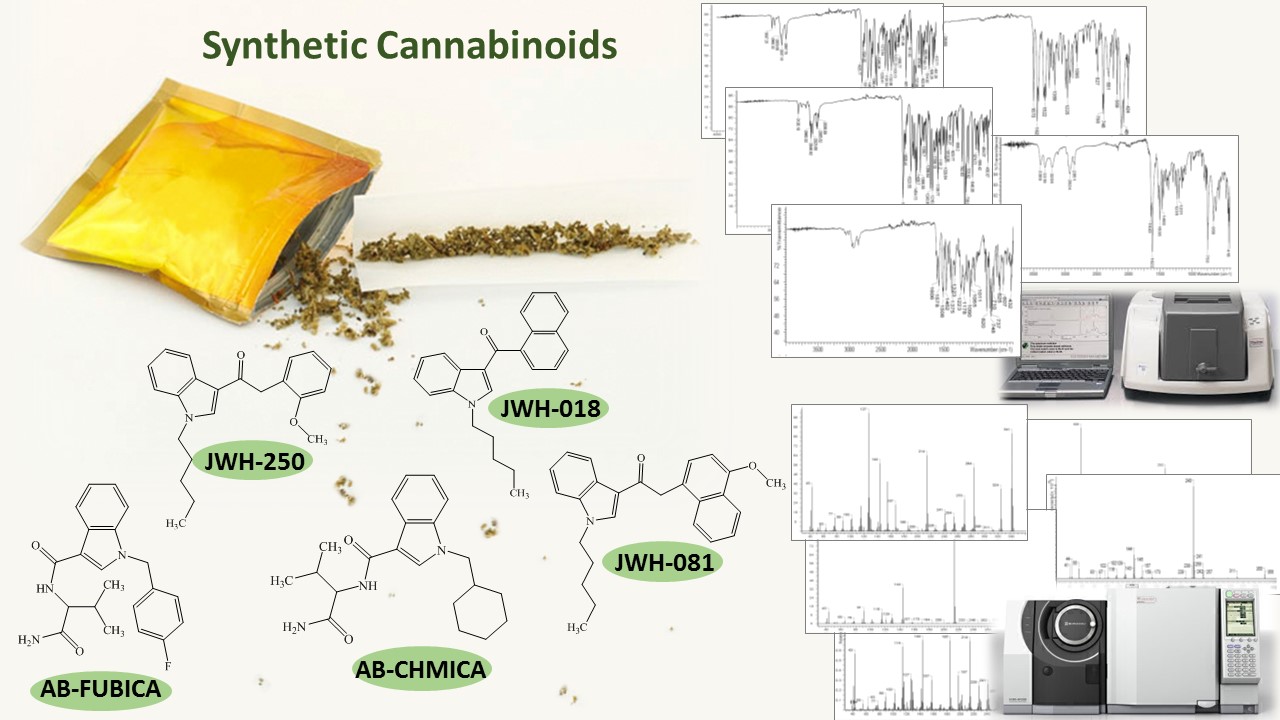Chemical and pharmaceutical research of cannabinoids as objects of forensic examination
DOI:
https://doi.org/10.15587/2519-4852.2024.299177Keywords:
synthetic cannabinoids, forensic analysis, spectral analysis, chromatographyAbstract
Synthetic cannabinoids are a group of psychoactive compounds that mimic the effects of Δ9-tetrahydrocannabinol, the main psychoactive component of marijuana. Today, the most important task in forensic science is to establish the chemical structure of new psychoactive compounds that appear in illicit trafficking promptly in order to respond quickly and stop their distribution. Less important is the development of methodological support for expert activity, including analysis methods and reference data on the analytical characteristics of compounds.
The aim. To develop stages of the forensic analysis of objects containing synthetic cannabinoids and propose methods for determining 5 new synthetic cannabinoids for forensic pharmaceutical purposes.
Materials and methods. The study was conducted as part of the identification of cannabinoids for forensic purposes at the National Scientific Centre "Bokarius Institute of Forensic Examination". As part of the study, 5 new synthetic cannabinoids were identified for forensic analysis using the following methods: infrared spectroscopy, thin-layer chromatography, and gas chromatography with a mass detector. The algorithm for the forensic analysis of cannabinoid derivatives was developed based on the requirements of Ukraine's current legislation.
Results. Spectral and chromatographic methods of determination of 5 new synthetic cannabinoids for forensic purposes were proposed, and during research and elaboration of the current legislation of Ukraine, an algorithm for forensic investigation of objects containing synthetic cannabinoids has been developed.
Conclusions. The stages of the forensic analysis of objects containing synthetic cannabinoids meet the requirements of the current legislation of Ukraine and the Ministry of Justice of Ukraine. The obtained data prove the high sensitivity and reproducibility of the methods and prove the possibility of their introduction into the practice of forensic examination
References
- Auwärter, V., de Morais, J., Gallegos, A., Evans-Brown, M., Christie, R., Jorge, R., Sedefov, R. (2021). Synthetic cannabinoids in Europe – a review. European Monitoring Centre for Drugs and Drug Addiction. Lisbon, 70.
- Soria, M. L. (2018). New psychoactive substances: Popular and dangerous. Spanish Journal of Legal Medicine, 44 (2), 64–72. https://doi.org/10.1016/j.remle.2017.11.005
- Pertwee, R. G. (2004). Pharmacological and therapeutic targets for Δ9 tetrahydrocannabinol and cannabidiol. Euphytica, 140 (1-2), 73–82. https://doi.org/10.1007/s10681-004-4756-9
- Recommended methods for the identification and analysis of cannabis and cannabis products (2022). Vienna: United Nations, United Nations Office on Drugs and Crime (UNODC), 72.
- Synthetic cannabinoids in herbal products (2011). Vienna: United Nations, 26.
- Atakan, Z. (2012). Cannabis, a complex plant: different compounds and different effects on individuals. Therapeutic Advances in Psychopharmacology, 2 (6), 241–254. https://doi.org/10.1177/2045125312457586
- Simon, T. A., Simon, J. H., Heaning, E. G., Gomez-Caminero, A., Marcu, J. P. (2023). Delta-8, a Cannabis-Derived Tetrahydrocannabinol Isomer: Evaluating Case Report Data in the Food and Drug Administration Adverse Event Reporting System (FAERS) Database. Drug, Healthcare and Patient Safety, 15, 25–38. https://doi.org/10.2147/dhps.s391857
- The challenge of new psychoactive substances (2013). United Nations Office on Drugs and Crime, 122.
- Ujváry, I. (2014). Psychoactive natural products: overview of recent developments. Annali dell'Istituto Superiore di Sanità, 50 (1), 12–27. https://doi.org/10.4415/ANN_14_01_04
- EMCDDA 2009 Thematic paper Understanding the ‘Spice’ phenomenon (2009). Luxembourg: Office for Official Publications of the European Communities, 37.
- Tai, S., Fantegrossi, W. E. (2016). Pharmacological and Toxicological Effects of Synthetic Cannabinoids and Their Metabolites. Current Topics in Behavioral Neurosciences, 249–262. https://doi.org/10.1007/7854_2016_60
- Tai, S., Fantegrossi, W. E. (2014). Synthetic Cannabinoids: Pharmacology, Behavioral Effects, and Abuse Potential. Current Addiction Reports, 1 (2), 129–136. https://doi.org/10.1007/s40429-014-0014-y
- Zakonodavstvo Ukrainy. Verkhovna rada Ukrainy. Available at: https://zakon.rada.gov.ua/laws/main/index
- Navarro-Tapia, E., Codina, J., Villanueva-Blasco, V. J., García-Algar, Ó., Andreu-Fernández, V. (2022). Detection of the Synthetic Cannabinoids AB-CHMINACA, ADB-CHMINACA, MDMB-CHMICA, and 5F-MDMB-PINACA in Biological Matrices: A Systematic Review. Biology, 11 (5), 796. https://doi.org/10.3390/biology11050796
- Muscat, R., Mheen, D., Barendregt, C. (2010). Towards an integrated policy on psychoactive substances: a theoretical and empirical analysis. Council of Europe Publishing, 75.
- Gehl R., Plecas D. (2016). Introduction to Criminal Investigation: Processes, Practices and Thinking. New Westminster: Justice Institute of British Columbia, 191.
- Mogollón, N. G. S., Quiroz-Moreno, C. D., Prata, P. S., de Almeida, J. R., Cevallos, A. S., Torres-Guiérrez, R., Augusto, F. (2018). New Advances in Toxicological Forensic Analysis Using Mass Spectrometry Techniques. Journal of Analytical Methods in Chemistry, 2018, 1–17. https://doi.org/10.1155/2018/4142527
- Harrison, S., Gas, L. (2011). GC-MS: an ideal tool for forensic analysis. Hydrocarbon Engineering, 33–36.
- Luethi, D., Liechti, M. E. (2020). Designer drugs: mechanism of action and adverse effects. Archives of Toxicology, 94 (4), 1085–1133. https://doi.org/10.1007/s00204-020-02693-7
- Sliwoski, G., Kothiwale, S., Meiler, J., Lowe, E. W. (2013). Computational Methods in Drug Discovery. Pharmacological Reviews, 66 (1), 334–395. https://doi.org/10.1124/pr.112.007336
- Sleeman, R., Carter, J. F. (2005). Mass spectrometry: Overview. Encyclopedia of Analytical Science. Elsevier, 337–344. https://doi.org/10.1016/b0-12-369397-7/00342-3
- Scientific Working Group for Forensic Toxicology (SWGTOX) Standard Practices for Method Validation in Forensic Toxicology (2013). Journal of Analytical Toxicology, 37 (7), 452–474. https://doi.org/10.1093/jat/bkt054

Downloads
Published
How to Cite
Issue
Section
License
Copyright (c) 2024 Igor Sych, Olena Bevz, Irina Sych, Nayak Sanjay Kumar, Olga Kryvanych, Olha Vislous, Vitaliy Yaremenko, Maryna Rakhimova, Lina Perekhoda

This work is licensed under a Creative Commons Attribution 4.0 International License.
Our journal abides by the Creative Commons CC BY copyright rights and permissions for open access journals.







